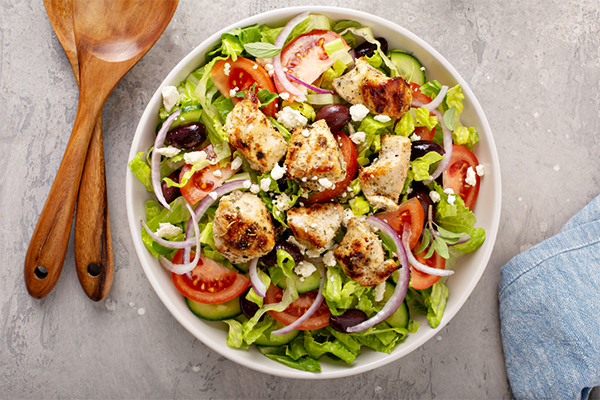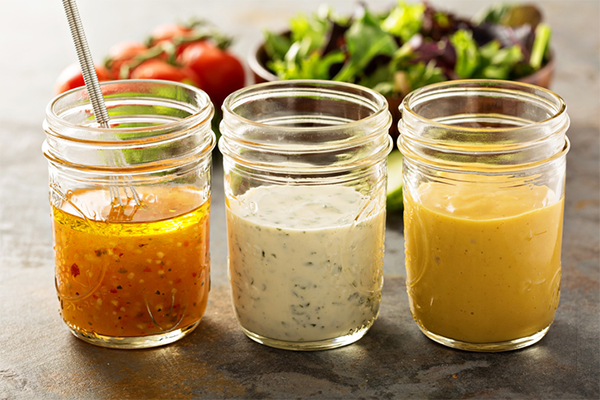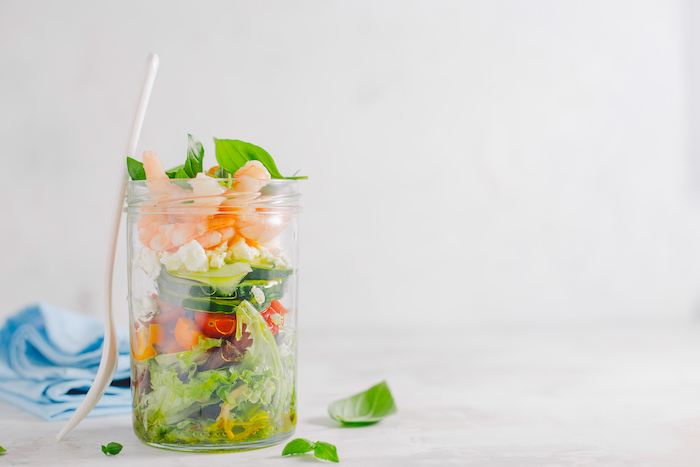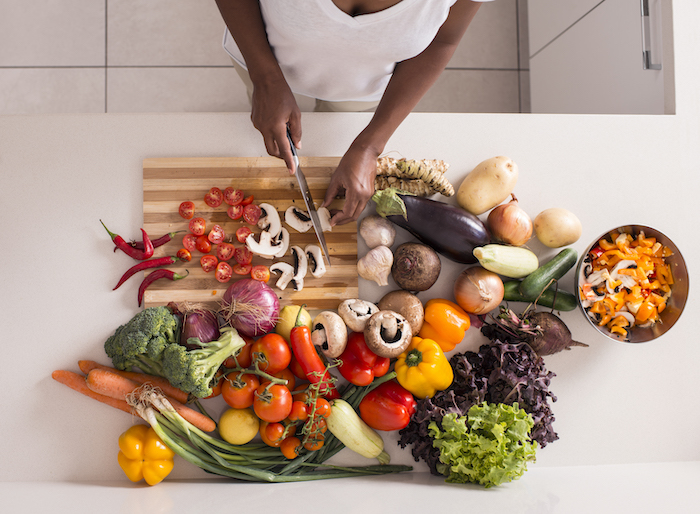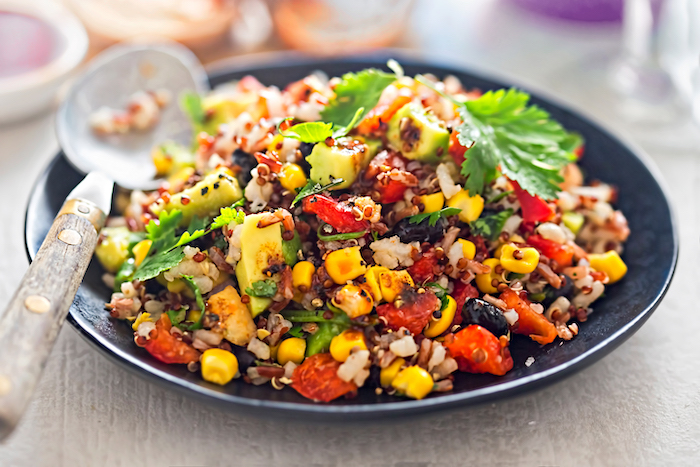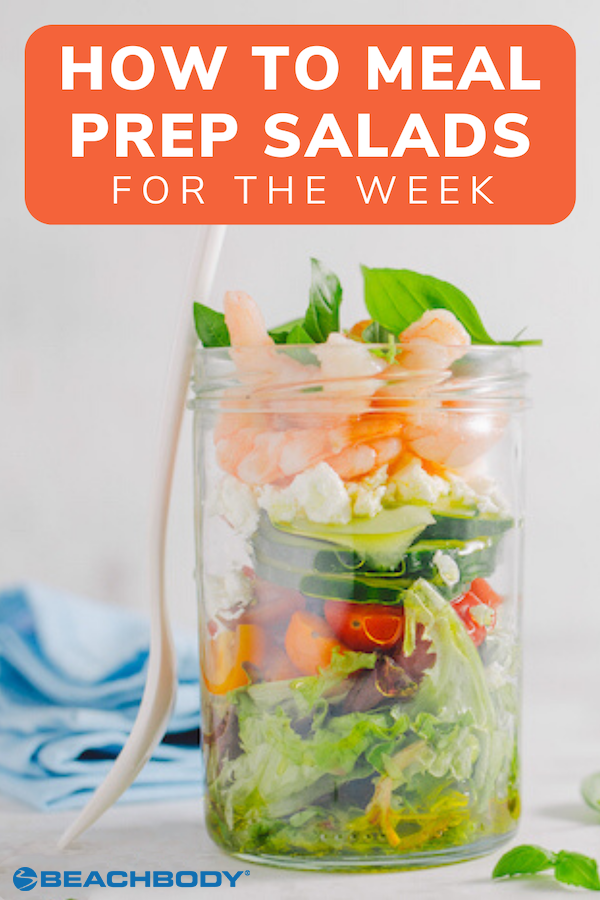When you’re looking to make better choices with your diet (or save some money!), one of the easiest things you can do is prep a week’s worth of meals in advance, so you have healthy food ready to go.
But is it possible to meal prep salads and keep them fresh all week?
We asked Kylie Burke, a certified holistic health coach and owner of Radiant and Abundant, to help us to put together some tips for beginners, including how to meal prep salads for the week.
How Do You Keep Salads Fresh for the Week?
While meal prepping food for your week can seem daunting, it can make it much easier to stick to your meal plan for the week and to save money.
The best part: It’s possible to prep everything you need for a week of salads ahead of time when you follow our steps.
1. Wash and portion greens
If you’re meal prepping a week of salads, the most important first step you can take is to wash and dry your greens.
They should be fully dry before you place them in the fridge.
If you want your morning departure to be super speedy, consider portioning your greens into different containers, one for each day of the week.
When you’re choosing which greens you’re going to use for your salad, keep in mind how long you need them to last in the fridge.
“Kale and purple cabbage, because they have more substantial body, aren’t going to wilt as fast as baby spinach or other light-bodied greens” like iceberg lettuce, Burke says.
2. Add some crunch
While the freshness of your salad greens is an important aspect of meal prepping for a week’s worth of eating, it’s also important to consider your taste buds.
If you get bored eating the same thing all the time, you’re more likely to skip the salad and pick up some fast food for lunch instead.
One easy way to keep your salads fresh each day is to create a variety of textures, one of which is crunch.
We crave crunchy foods, and it’s important to give that to yourself through healthy toppings instead of an afternoon bag of chips.
Some great topping options to add crunch to your salad include:
- Toasted nuts
- Pepitas or pumpkin seeds
- Whole wheat croutons
- Tortilla strips
- Sunflower seeds
- Toasted coconut
- Chia seeds
- Crunchy veggies such as carrots, radishes, or snap peas
3. Don’t forget the protein
Adding an element of protein to your salad will help you to stay full longer, and it also adds another component to your meal which can be switched up from day to day.
If you do choose to add protein to your salad, you’re likely going to want to store this separately from your other ingredients to maintain freshness (more on that below).
Here some protein ideas to add to your salad:
- Chicken (Burke recommends buying a rotisserie chicken and shredding it for cheap and easy food prep)
- Steak
- Beans
- Tofu or tempeh
- Beans
- Nuts
4. Prep toppings
When it comes to toppings, the most important thing to remember is that you should work smarter, not harder.
“If you’re short on time, let the store do the work for you!” says Burke. “Easy meal prep is done with pre-prepped items like shredded cabbage, shredded carrots, sliced radishes, or anything else that’s pre-chopped at your grocery store.”
Your toppings should be stored separately from your greens to ensure high-quality freshness — or you can use a layering technique to keep everything in one container (again, more on that below).
5. Experiment with salad dressings
While there are tons of ready-made, healthy salad dressings on the market, you can also make your own in a food processor with minimal effort.
Have a few dressings on hand to instantly change up the flavor profile of your salads.
Here are a few of Kylie’s favorites to add variety:
- Peanut dressing for a Thai kick
- Ranch for a Cobb salad
- Vinegar and olive oil for a Greek salad
- Miso dressing for Asian flair
- Sriracha for some kick
6. Use multiple containers
Once you’ve gotten all your various ingredients ready for the week, having the right containers on hand can make all the difference.
You’ll want a variety of sizes, and if possible, enough containers that you don’t have to wash them each night to re-pack for the next day.
For each day that you’re prepping a salad, you’ll want containers for these ingredients:
- A large container for greens. Make sure this container is big enough so you can combine all of your ingredients from other containers and eat right out of this one.
- A medium container for wet ingredients. This might include tomatoes, onions, and cucumbers.
- A small container for your dressing. Pour it on when you’re ready to eat, and not a moment before.
While you don’t have to keep your ingredients separate, this can help maintain the crispness of your greens and keep them fresh as your week continues.
It’s especially important to keep your dressing separate, though, as that can wilt greens in a few hours.
7. …Or deploy strategic layering
If you don’t have the time or the Tupperware to keep your greens separate from the other ingredients in your salads, strategic layering is helpful.
“Place the heavy items on the bottom so as not to crush your greens,” says Kylie. “This will prevent items from going bad as quickly.”
Grains, proteins, and cheeses go at the bottom, then work your way up to cooked veggies, raw veggies, and lastly your greens.
This keeps your greens fresher and will keep them from getting smashed or mushy.
Even with layering, though, you still need to be wary of wet ingredients such as chopped tomatoes, which can wilt your greens quickly.
8. Add something absorbent
One way to keep your greens looking fresh in the fridge during the week is to place a paper towel in the bottom of the container where you’re storing them.
This will help absorb any excess moisture and ensure your greens stay fresh. Just make sure to remove it before eating.
If you’re keeping wet ingredients in the same container for a salad to be eaten that day, you can also use a paper towel to separate the ingredients and protect your greens.
How to Keep From Getting Bored
Simple changes such as the toppings you put on your salad or the dressing you use can ensure that your salads stay fresh on your taste buds all week and keeps you satiated.
Here are a couple tips.
1. Prioritize variety when you’re shopping
Challenge yourself to avoid buying the same ingredients every week. When you’re shopping, consider the following:
- Look for a variety of bright colors to get different vitamins and antioxidants.
- Choose a flavor boost such as citrus, fresh herbs, or dried fruits.
- Consider adding pickled or fermented elements such as pickled beets or carrots, kimchi, or even sauerkraut.
- Make sure your toppings lend a variety of textures to your meal.
2. Skip the lettuce
Salad doesn’t always have to include lettuce. You can use lettuce at the beginning of the week and then replace it towards the end of the week with a heartier green such as kale.
That helps to avoid the wilted-lettuce Thursday salad.
3. Skip leafy greens entirely
Or if you’re up for trying some alternative salad types, consider having salad at the beginning of the week and then evolving into grain bowls towards the end of the week.
Grain bowls can be very veggie-centric — and easier to preserve in the fridge for a week at a time.



























